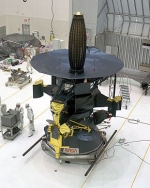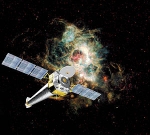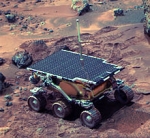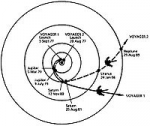Displaying items by tag: spacecraft
IKAROS
IKAROS (Interplanetary Kite-craft Accelerated by Radiation Of the Sun) is a Japan Aerospace Exploration Agency (JAXA) experimental spacecraft. The spacecraft was launched on 21 May, 2010, aboard an H-IIA rocket, together with the Akatsuki (Venus Climate Orbiter) probe and four other small spacecraft. IKAROS is the first spacecraft to successfully demonstrate solar-sail technology in interplanetary space.
On December 8, 2010, IKAROS passed by Venus at about 80,800 km distance, completing the planned mission successfully, and entered its extended operation phase.
The IKAROS probe is the world's first spacecraft to use solar sailing as the main propulsion. It plans to demonstrate four key technologies (comments in parentheses refer to figure):
- Deployment and control of a large, thin solar sail membrane (blue areas numbered 3)
- Thin-film solar cells integrated into the sail to power the payload (black rectangles numbered 4)
- Measurement of acceleration due to radiation pressure on the solar sail
- Attitude control via variable reflectance liquid crystal panels (orange rectangles numbered 2)
The mission also includes investigations of aspects of interplanetary space, such as the gamma-ray burst, solar wind and cosmic dust.
The probe's ALADDIN instrument (ALDN-S and ALDN-E) measured the variation in dust density while its Gamma-Ray Burst Polarimeter (GAP) measured the polarization of gamma-ray bursts during its six month cruise.
If successful, IKAROS is to be followed by a 50 m (160 ft) sail, intended to journey to Jupiter and theTrojan asteroids, later in the decade.
International Space Station (ISS)
The International Space Station (ISS) is a habitable artificial satellite in low Earth orbit. It follows the Salyut, Almaz, Skylab and Mir stations as the ninth space station to be inhabited. The ISS is a modular structure whose first component was launched in 1998. Like many artificial satellites, the station can be seen from Earth with the naked eye. The ISS consists of pressurised modules, external trusses, solar arrays and other elements. ISS components have been launched by American Space Shuttles as well as Russian Proton and Soyuz rockets. Budget constraints led to the merger of three space station projects with the Japanese Kibō module and Canadian robotics. In 1993 the Soviet/Russian Mir-2, the American Freedom, and the European Columbus, merged into a single multi-national programme. The Russian Federal Space Agency plans to separate some of its modules from the Russian segment to form theOPSEK facility before the remainder of the station is deorbited.
The ISS serves as a microgravity and space environment research laboratory in which crew members conduct experiments in biology, human biology, physics, astronomy, meteorology and other fields. The station is suited for the testing of spacecraft systems and equipment required for missions to the Moon and Mars.
The station has been continuously occupied for 11 years and 121 days having exceeded the previous record of almost 10 years (or 3,644 days) held by Mir, in 2010. The station is serviced by Soyuz spacecraft,Progress spacecraft, the Automated Transfer Vehicle, the H-II Transfer Vehicle, and formerly the Space Shuttle. It has been visited by astronauts and cosmonauts from 15 different nations.
The ISS programme is a joint project between five participating space agencies, the American NASA, the Russian RKA, the Japanese JAXA, the European ESA, and the Canadian CSA. The ownership and use of the space station is established by intergovernmental treaties and agreements. The station is divided into two sections, the Russian orbital segment (ROS) and the United States orbital segment(USOS), which is shared by many nations. The ISS is maintained at an orbital altitude of between 330 km (205 mi) and 410 km (255 mi). It completes 15.7 orbits per day. The ISS is expected to remain in operation until at least 2020, and potentially to 2028.
Galileo (NASA spacecraft)
The Galileo spacecraft was an unmanned spacecraft sent by NASA to study the planet Jupiter and its moons. Named after the astronomer and Renaissance pioneer Galileo Galilei, it was launched on October 18, 1989 by the Space Shuttle Atlantis on the STS-34 mission. It arrived at Jupiter on December 7, 1995, a little more than six years later, via gravitational assist flybys of Venus and Earth.
Despite suffering from antenna problems, Galileo conducted the first asteroid flyby near 951 Gaspra, discovered the first asteroid moon, Dactyl, around the asteroid 243 Ida, and was the first spacecraft to orbit Jupiter. It furthermore launched the first probe into Jupiter's atmosphere.
The spacecraft measured the atmospheric composition of Jupiter and directly observed ammonia clouds, which seem to be created by an outflow from the lower depths of Jupiter's atmosphere. Galileo also registered Io's volcanism and the plasma interactions between its and Jupiter's atmospheres. Other studies gave support for the popular theory of liquid oceans under the icy surface of Europa. There were also indications of similar liquid-saltwater layers under the surfaces of Ganymede and Callisto, while Ganymede was shown to possess a magnetic field. New evidence was also found for the existence of exospheres around Europa, Ganymede, and Callisto.
It was furthermore discovered that Jupiter's faint ring system is formed by dust from impacts on the four small inner moons. The extent and structure of Jupiter's magnetosphere was also mapped.
Galileo also provided the only direct observation of Comet Shoemaker-Levy 9's impact into the atmosphere of Jupiter in 1994.
On September 21, 2003, after 14 years in space and 8 years of service in the Jovian system, Galileo's mission was terminated by sending the orbiter into Jupiter's atmosphere at a speed of nearly 50 kilometres per second to avoid any chance of it contaminating local moons with bacteria from Earth. Of particular concern was the ice-crusted moon Europa, which, thanks to Galileo, scientists now suspect harbors a potentially life-supporting saltwater ocean beneath its surface.
Chandra X-ray Observatory
The Chandra X-ray Observatory is a satellite launched on STS-93 by NASA on July 23, 1999. It was named in honor of Indian-American physicist Subrahmanyan Chandrasekharwho is known for determining the maximum mass for white dwarfs. "Chandra" also means "moon" or "luminous" in Sanskrit.
Chandra Observatory is the third of NASA's four Great Observatories. The first was Hubble Space Telescope; second the Compton Gamma Ray Observatory, launched in 1991; and last is the Spitzer Space Telescope. Prior to successful launch, the Chandra Observatory was known as AXAF, the Advanced X-ray Astrophysics Facility. AXAF was assembled and tested by TRW (now Northrop Grumman Aerospace Systems) in Redondo Beach,California. Chandra is sensitive to X-ray sources 100 times fainter than any previous X-ray telescope, due primarily to the high angular resolution of the Chandra mirrors.
Since the Earth's atmosphere absorbs the vast majority of X-rays, they are not detectable from Earth-based telescopes, requiring a space-based telescope to make these observations.
Mars Pathfinder
Mars Pathfinder (MESUR Pathfinder) was an American spacecraft that landed a base station with roving probe onMars in 1997. It consisted of a lander, renamed the Carl Sagan Memorial Station, and a lightweight (10.6 kilograms/23 pounds) wheeled robotic rover named Sojourner.
Launched on December 4, 1996 by NASA aboard a Delta II booster a month after the Mars Global Surveyor was launched, it landed on July 4, 1997 on Mars' Ares Vallis, in a region called Chryse Planitia in the Oxia Palus quadrangle. The lander then opened, exposing the rover which conducted many experiments on the Martian surface. The mission carried a series of scientific instruments to analyze the Martian atmosphere, climate, geology and the composition of its rocks and soil. It was the second project from NASA's Discovery Program, which promotes the use of low-cost spacecraft and frequent launches under the motto "cheaper, faster and better" promoted by the then administrator, Daniel Goldin. The mission was directed by the Jet Propulsion Laboratory (JPL), a division of the California Institute of Technology, responsible for NASA's Mars Exploration Program.
Voyager program
The Voyager program is a U.S program that launched two unmanned space missions, scientific probes Voyager 1 and Voyager 2. They were launched in 1977 to take advantage of a favorable planetary alignment of the late 1970s.
Although officially designated to study just Jupiter and Saturn, the probes were able to continue their mission into the outer solar system, and are as of December 2011 on course to exit the solar system. These probes were built at JPL and were funded by NASA. Voyager 1 is currently the farthest human-made object from Earth.
Both missions have gathered large amounts of data about the gas giants of the solar system, of which little was previously known. In addition, the spacecraft trajectories have been used to place limits on the existence of a hypothetical trans-Plutonian Planet X.
Kepler (mission & spacecraft)
The Kepler spacecraft is an American space observatory, the space-based portion of NASA's Kepler mission to discover Earth-like planets orbiting other stars. The spacecraft is named in honor of the 17th-century German astronomer Johannes Kepler. The spacecraft was launched on March 7, 2009, with a planned mission lifetime of at least 3.5 years.
The Kepler mission is "specifically designed to survey a portion of our region of theMilky Way galaxy to discover dozens of Earth-size planets in or near the habitable zone and determine how many of the billions of stars in our galaxy have such planets." Kepler's only instrument is a photometer that continuously monitors the brightness of over 145,000 main sequence stars in a fixed field of view. This data isanalyzed to detect periodic fluctuations that indicate the presence of extrasolar planets that are in the process of crossing the face of other stars.








